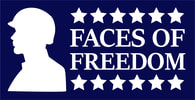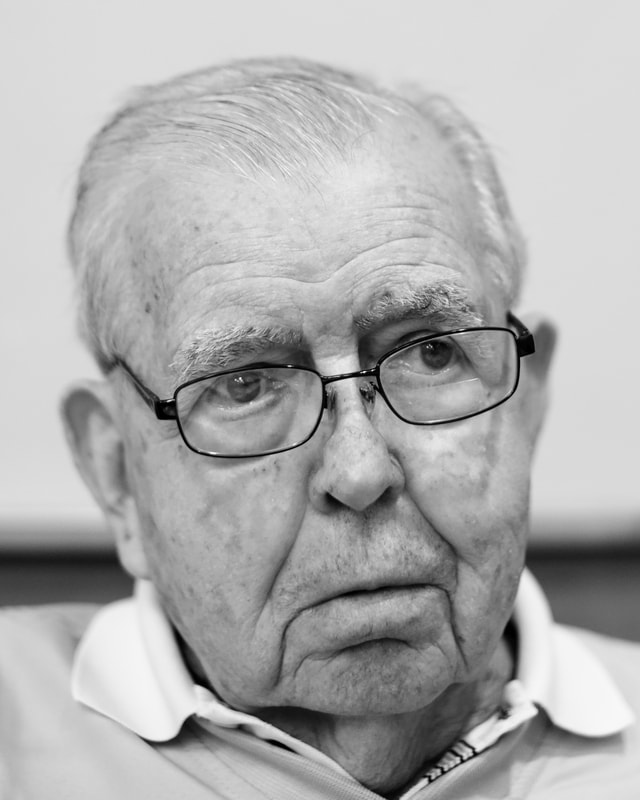CPL. L.C. Poor
US Marine Corp. Aircraft Technician
Marine Fighter Squadron 115 (VMF 115)
Luzon, Philippines Jan ’44 – Aug ‘46
US Marine Corp. Aircraft Technician
Marine Fighter Squadron 115 (VMF 115)
Luzon, Philippines Jan ’44 – Aug ‘46
L.C. Poor was born in 1926 in Brevard, NC. and was one of nine children – three brothers and five sisters. “I didn’t know we were in a Depression at that time. I thought that was just the way the world worked.” His father worked for the local lumber company as a machinist which was one of the only businesses around at the time.
L.C. was attending Brevard High School and playing football, baseball and basketball when the Japanese attacked Pearl Harbor. He remembers the entire country being patriotic and everyone wanting to do their part. He wanted to enlist immediately and he wanted to join the Marine Corp. “I wanted to kill some Japanese and I thought the Marines was the best way to get there.” He was only 17 and he needed his parents to sign his papers to enlist but they refused. However, close to his 18th birthday they agreed to give their permission and L.C. dropped out just before basketball season. In January of ‘44 he was headed to Parris Island for boot camp.
There were 71 people in his platoon and L.C. was looking forward to being in the infantry. Unfortunately, the Marines had other plans for him based on his scores on certain technical tests he took. After boot camp he was one of two Marines that didn’t move on to Camp Lejeune. He was sent to Cherry Point. “It was like being cut from the varsity. I was really disappointed.”
He quickly was transferred from Cherry Point to trade school in Norman Oklahoma. 21 weeks later after completing Aircraft Mechanic School he was sent to Miramar near San Diego and after approximately 6 weeks he was on a ship with 4,000 Marines and 500 nurses. The ship made port in Hawaii where the nurses disembarked and the Marines continued on. For the next 31 days they zig-zagged their way across the Pacific but did not know where they were headed. The zig-zagging was necessary to make it harder for enemy submarines to track them. Eventually they reached the Admiralty Island and then they docked at Luzon in the Philippines. L.C. went ashore and joined his squadron in Zamboanga, just south of Luzon. They were based at an airfield that was previously a coconut plantation.
L.C.’s unit was known as “Joe’s Jokers” after Major Joe Foss who was a Marine Fighter Ace and was awarded the Medal of Honor during the Guadalcanal Campaign. The squadron had 24 aircraft known as F 4U Corsairs. He was “on the line” and the crew chief for the CO’s plane. His duties included starting the plane, letting it idle, then revving the engine to 2,200 rpms, which was the takeoff speed. He would also use hand signals to direct the plane on and off the runway during taxi. Later, he qualified to be a taxi pilot where he would get into the cockpit and taxi the planes.
The aircraft in his squadron were involved mostly in ground support and dropped more napalm than bombs. Delivering napalm required the pilots to fly much lower because the napalm did not have fins for direction like a bomb did. They tried to drop the napalm near the mouth of a cave where it would burn so intensely it would draw all of the oxygen out of the caves and the Japanese with it.
The war ended in August ’45 and L.C.’s squadron was sent to Peking, China, now known as Beijing. It was a 13 day trip by train and they arrived around Thanksgiving to very cold weather. It was particularly cold compared to the heat of the tropics they experienced in the Philippines. L.C. and his unit were there until August of ’46 when he returned to San Diego. He caught a flight to Cherry Point in Eastern North Carolina and was discharged on August 25th, 1946.
When L.C. got back to Brevard he enrolled in a program to complete his high school degree given by Brevard College. He then enrolled in Brevard College, which was a junior college at the time with the intention of becoming a teacher. A friend who was a teacher at Brevard High School told him he could earn more working at the local paper mill than he could ever earn as a teacher. L.C. decided that sounded good to him and in January of 1948 he landed a job at Ecusta Paper which made paper for cigarettes. He started out in the Machine Room and was then moved into the main office. He had some accounting classes so he handled cost accounting and inventory management. 33 years later he retired.
While he was working at Ecusta he met Frances Scruggs, known as Hicks by her friends. In February 1950 they were married and built a house in Brevard right next to the house where Hicks was born and raised. They were married one month short of 70 years when Frances passed away. They had two sons who both graduated from Appalachian State.
L.C. was an avid jogger and after retirement he has hiked many of the trails in Pisgah National Forest.
“I’ve had a good life and I don’t feel like I am any kind of a hero at all.”
Thank you L.C. for keeping those planes in the air, keeping those pilots safe and helping to bring an end to the war in the Pacific.
L.C. was attending Brevard High School and playing football, baseball and basketball when the Japanese attacked Pearl Harbor. He remembers the entire country being patriotic and everyone wanting to do their part. He wanted to enlist immediately and he wanted to join the Marine Corp. “I wanted to kill some Japanese and I thought the Marines was the best way to get there.” He was only 17 and he needed his parents to sign his papers to enlist but they refused. However, close to his 18th birthday they agreed to give their permission and L.C. dropped out just before basketball season. In January of ‘44 he was headed to Parris Island for boot camp.
There were 71 people in his platoon and L.C. was looking forward to being in the infantry. Unfortunately, the Marines had other plans for him based on his scores on certain technical tests he took. After boot camp he was one of two Marines that didn’t move on to Camp Lejeune. He was sent to Cherry Point. “It was like being cut from the varsity. I was really disappointed.”
He quickly was transferred from Cherry Point to trade school in Norman Oklahoma. 21 weeks later after completing Aircraft Mechanic School he was sent to Miramar near San Diego and after approximately 6 weeks he was on a ship with 4,000 Marines and 500 nurses. The ship made port in Hawaii where the nurses disembarked and the Marines continued on. For the next 31 days they zig-zagged their way across the Pacific but did not know where they were headed. The zig-zagging was necessary to make it harder for enemy submarines to track them. Eventually they reached the Admiralty Island and then they docked at Luzon in the Philippines. L.C. went ashore and joined his squadron in Zamboanga, just south of Luzon. They were based at an airfield that was previously a coconut plantation.
L.C.’s unit was known as “Joe’s Jokers” after Major Joe Foss who was a Marine Fighter Ace and was awarded the Medal of Honor during the Guadalcanal Campaign. The squadron had 24 aircraft known as F 4U Corsairs. He was “on the line” and the crew chief for the CO’s plane. His duties included starting the plane, letting it idle, then revving the engine to 2,200 rpms, which was the takeoff speed. He would also use hand signals to direct the plane on and off the runway during taxi. Later, he qualified to be a taxi pilot where he would get into the cockpit and taxi the planes.
The aircraft in his squadron were involved mostly in ground support and dropped more napalm than bombs. Delivering napalm required the pilots to fly much lower because the napalm did not have fins for direction like a bomb did. They tried to drop the napalm near the mouth of a cave where it would burn so intensely it would draw all of the oxygen out of the caves and the Japanese with it.
The war ended in August ’45 and L.C.’s squadron was sent to Peking, China, now known as Beijing. It was a 13 day trip by train and they arrived around Thanksgiving to very cold weather. It was particularly cold compared to the heat of the tropics they experienced in the Philippines. L.C. and his unit were there until August of ’46 when he returned to San Diego. He caught a flight to Cherry Point in Eastern North Carolina and was discharged on August 25th, 1946.
When L.C. got back to Brevard he enrolled in a program to complete his high school degree given by Brevard College. He then enrolled in Brevard College, which was a junior college at the time with the intention of becoming a teacher. A friend who was a teacher at Brevard High School told him he could earn more working at the local paper mill than he could ever earn as a teacher. L.C. decided that sounded good to him and in January of 1948 he landed a job at Ecusta Paper which made paper for cigarettes. He started out in the Machine Room and was then moved into the main office. He had some accounting classes so he handled cost accounting and inventory management. 33 years later he retired.
While he was working at Ecusta he met Frances Scruggs, known as Hicks by her friends. In February 1950 they were married and built a house in Brevard right next to the house where Hicks was born and raised. They were married one month short of 70 years when Frances passed away. They had two sons who both graduated from Appalachian State.
L.C. was an avid jogger and after retirement he has hiked many of the trails in Pisgah National Forest.
“I’ve had a good life and I don’t feel like I am any kind of a hero at all.”
Thank you L.C. for keeping those planes in the air, keeping those pilots safe and helping to bring an end to the war in the Pacific.

